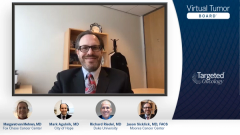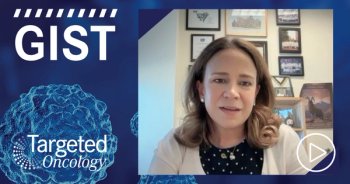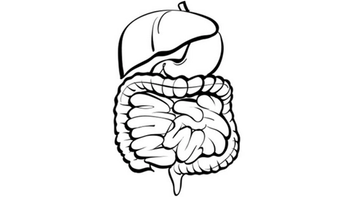
Case 2: KIT Exon 9-Mutated GIST
The experts present and discuss a case of a patient with KIT exon 9-mutated GIST, an including an overview of surgical options.
Episodes in this series

Richard Riedel, MD: Let’s discuss the second case. This patient has a KIT exon 9 mutation. Imagine a 56-year-old man who presents with abdominal fullness, decreased appetite, and changes in stools. His past medical history is significant for diabetes. Otherwise, he has no other significant medical problems. No significant family history. On exam, he appears fatigued. He has some abdominal distension but otherwise an unremarkable exam. Labs reveal a hemoglobin of 9.3 g/dL. Other labs are within normal limits. Then an endoscopic procedure was performed, which reveals no clear source of bleeding.
Cross-axial imaging with a CT scan reveals a 7-cm small bowel mass in the jejunum near the superior mesenteric artery, and there are multiple jejunal arteries in close proximity. Endoscopic ultrasound with biopsy reveals GIST [gastrointestinal stromal tumor] with IHC [immunohistochemistry] positive for CD34 and CD117. Next-generation sequencing reveals a KIT exon 9 mutation. Overall, the patient is staged as a stage IIIB GIST, and the patient has a good performance status.
Jason, I’d be interested to hear your thoughts on surgical options for a patient with a small-bowel GIST, at least as presented in this particular case.
Jason Sicklick, MD, FACS: It’s a great question in terms of whether to operate first vs thinking about giving neoadjuvant therapy. Really, it’s all about location. If you’ve got a small-bowel GIST that’s large, but somewhere in the mid-small bowel away from the vessels, then that would be a scenario in which it would not be unreasonable just to go straight to operation to resect it.
This is probably more complicated in that it looks like it’s a proximal tumor that’s going to be fairly close to the superior mesenteric artery. It comes down to having an experienced surgeon reviewing the imaging to assess whether it’s technically feasible and safe to try to resect at that point or to think about trying to give neoadjuvant therapy to shrink it down, to make the operation safer and easier, with the goal of trying to preserve those mesenteric vessels. Obviously you can’t take the superior mesenteric artery or sometimes very proximal branches, because it might compromise the vascular supply to the small bowel, and it’s really an anatomical question that needs to be considered when making the decision about surgery first vs surgery later.
Richard Riedel, MD: My surgeons will often remind me that these can be very vascular tumors, and sometimes they’re friable. Do you find that if there is consideration for neoadjuvant imatinib, the consistency of the tumor changes at the time of operation in terms of maybe thickening up or making it easier to remove?
Jason Sicklick, MD, FACS: As it shrinks down or as it responds to therapy, 1 of 2 things happens. One is it will shrink down in size. But often they become almost soft and a little mushier, and you have to be very careful about not rupturing them because you’ve got a necrotic center often to the tumors. Alternatively, sometimes when we see this almost pseudo progression in some of the tumors. They become almost cystic in a sense as they necrose. Potential for rupture is also a possibility in those types of scenarios, so you must be very cognizant of that as you’re handling it.
Sometimes you’re considering whether you’re going to do an open approach vs a laparoscopic approach. Sometimes you lose that tactile sensation with a laparoscopic approach, and the risk may be higher of rupturing that tumor, which then has long-term ramifications for peritoneal-based seating. You can certainly see the mixed responses in terms of the way the consistency is for the tumors, and that needs to be considered as well.
Margaret von Mehren, MD: In the first days of using imatinib there was information from Dr Peter Hohenberger in Germany, who described doing a resection on a patient with or without preoperative Gleevec and described less blood loss, less need for transfusion, and shorter hospital courses. There clearly is an impact in terms of vascularity and what you were mentioning, Rich, in terms of resectability from that perspective.
Richard Riedel, MD: When we think about other solid tumors—for example, non-GIST solid tumors—oftentimes biopsies are done, for example, transabdominally or transthoracic. In this case, it’s done endoscopically. Can you talk about the importance of endoscopic biopsies and the potential benefits there, as opposed to let’s say transabdominal biopsies and making diagnoses.
Jason Sicklick, MD, FACS: If you talk about the role of endoscopic biopsy, obviously the biopsy is going to give us a tissue diagnosis, No. 1. No. 2, it will give us the potential for doing genetic testing to look for KIT exon 11 vs an exon 9 as seen here vs often in the scenario of proximal small bowel tumors. There’s another location where patients can also have BRAF-mutant GIST or NF1-mutant GIST.
There was a study that was out of a Dutch and British study that came out in the Annals of Surgery last year that actually looked at the role of seeding secondary to endoscopic vs transabdominal or percutaneous biopsies. There was no difference in rates of peritoneal-based seeding or seeding of the track between the 2 studies, albeit a retrospective analysis in 2 institutions.
In general, if I had my preference, I will generally go with an endoscopic biopsy over a percutaneous biopsy just because there is that theoretical risk that we all worry about and talk about.
Margaret von Mehren, MD: I’m not sure if it was the EORTC [European Organisation for Research and Treatment of Cancer] or the Scandinavian adjuvant trial that took a look at that. At least in patients who got adjuvant therapy, they didn’t see any difference in terms of risk for seeding.
Richard Riedel, MD: In our practice, our surgeons will often talk about the risk of extraluminal bleeding, as opposed to intraluminal bleeding and whether or not that is of significance or not. But we also will sort of follow practice of endoscopic-guided biopsies when possible. Mark, how about your practice?
Mark Agulnik, MD: We’ve always done—in the last few years certainly—the endoscopic-guided biopsies. Then I allow it to be a surgical decision to be made with the patient on whether they should be doing imatinib up front vs pursuing surgery. If they feel that a smaller tumor will derive a better outcome and less morbidity, then I have no problem starting with imatinib up front at 400 mg and trying to get some shrinkage. Then I scan every 3 months, and the moment we have an optimal amount of shrinkage or the surgeons feel that they’re ready, we take the patients to surgery at that point.
Transcript edited for clarity.













































